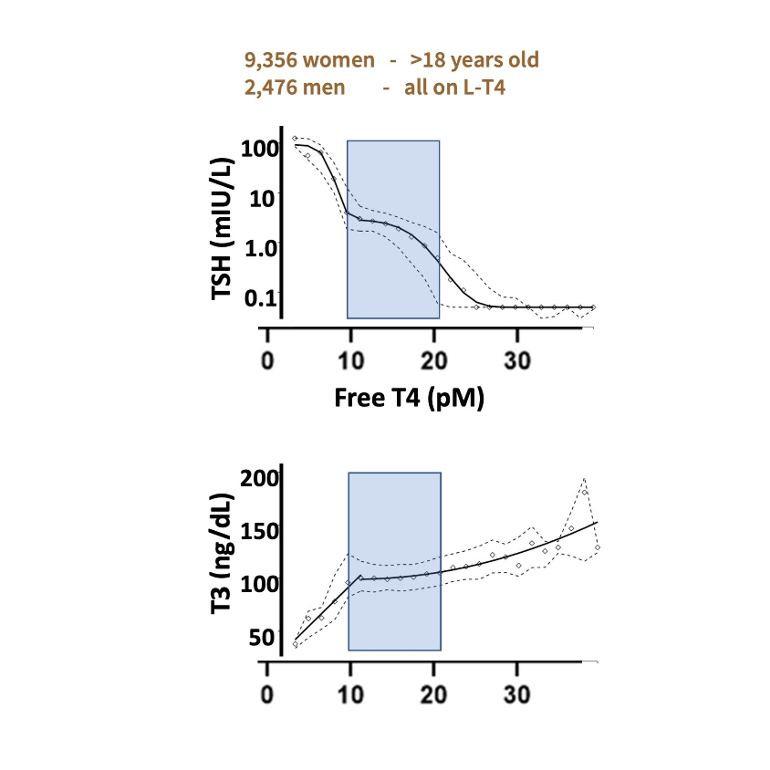Comment by Bianco:
In LT4-treated patients (blue box=ref. FT4 range), the increase in FT4 is associated with a major drop in TSH, but the increase in blood T3 is minimal. LT4 is really good at normalizing TSH; not nearly as good at restoring T3, the active thyroid hormone.
I don't think many members who have real experience will be surprised by this. Only disappointed that it has taken this long to even get here - which is not far enough.
J Clin Endocrinol Metab
. 2022 Dec 14;dgac725.
doi: 10.1210/clinem/dgac725. Online ahead of print.
Serum Thyrotropin and Triiodothyronine Levels in Levothyroxine-Treated Patients
Matthew D Ettleson 1 , Wesley H Prieto 2 , Pedro S T Russo 2 , Jose de Sa 2 , Wen Wan 3 , Neda Laiteerapong 3 , Rui M B Maciel 2 4 , Antonio C Bianco 1
Affiliations
• PMID: 36515655
• DOI: 10.1210/clinem/dgac725
Abstract
Context: Small adjustments in LT4 dose do not appear to provide clinical benefit despite changes in TSH levels within the reference range. We hypothesize that the accompanying changes in serum T3 levels do not reflect the magnitude of the changes in serum TSH.
Objective: Characterize the relationships of serum FT4 vs T3, FT4 vs TSH, and FT4 vs the T3/FT4 ratio.
Design: Cross-sectional observational study.
Setting: A large clinical database from January 1, 2009, to December 31, 2019.
Participants: 9850 participants aged 18 years and older treated with LT4.
Exposure: Treatment with LT4, subdivided by serum FT4 levelMain Outcome Measures: Model fitting of the relationships between serum FT4 vs TSH, FT4 vs T3, and FT4 vs T3/FT4. Mean and median values of TSH, T3, and T3/FT4 were calculated.
Results: The relationships T3 vs FT4 and TSH vs FT4 were both complex and best represented by distinct, segmented regression models. Increasing FT4 levels were linearly associated with T3 levels until an inflection point at a FT4 level of 0.7 ng/dL, after which a flattening of the slope was observed following a convex quadratic curve. In contrast, increasing FT4 levels were associated with steep declines in TSH following two negative sigmoid curves. The FT4 vs T3/FT4 relationship was fit to an asymptotic regression curve supporting less T4 to T3 activation at higher FT4 levels.
Conclusions: In LT4-treated patients, the relationships between serum FT4 vs TSH and FT4 vs T3 across a range of FT4 levels are disproportionate. As a result, dose changes in LT4 that robustly modify serum FT4 and TSH values may only minimally affect serum T3 levels and result in no significant clinical benefit.
Keywords: hypothyroidism; levothyroxine; thyrotropin; triiodothyronine.
Full paper is not yet published and is behind a paywall.
pubmed.ncbi.nlm.nih.gov/365...
I am reminded of this paper from 1995:
Replacement therapy for hypothyroidism with thyroxine alone does not ensure euthyroidism in all tissues, as studied in thyroidectomized rats.
europepmc.org/article/MED/8...
diogenes - any comments appreciated.
Adding emphasis: This paper is based on Total T3 - not Free T3.

 ones a ratter though and rather sees the small black cat as 'probably just a big rat'. 🫣😂
ones a ratter though and rather sees the small black cat as 'probably just a big rat'. 🫣😂